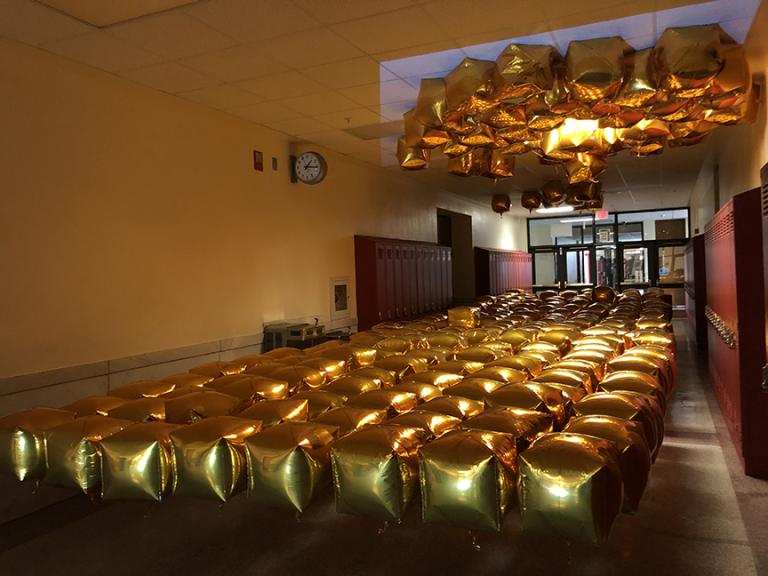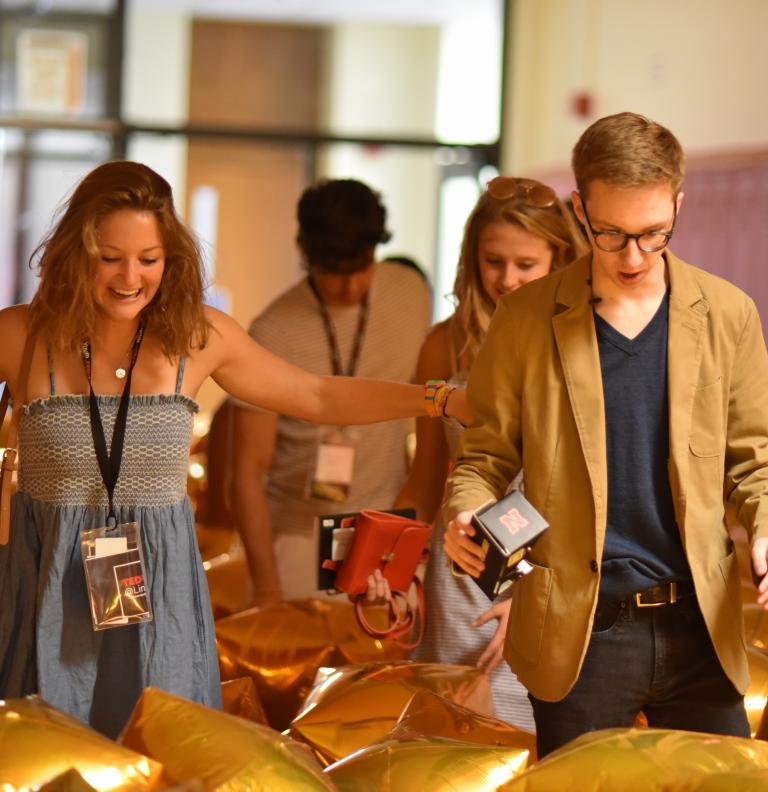
Immersive art installation created for TEDx Youth Event in Lincoln
calendar icon17 Sep 2018

Lincoln, Neb.--Christopher Irvin, a lecturer in the School of Art, Art History & Design and Johnny Carson School of Theatre and Film, led the creation of an immersive art installation titled “Almost Disney” for a TEDxYouth@Lincoln event on Aug. 11 at Lincoln High School.
More than 350 students from Nebraska’s high schools, middle schools and colleges, along with teachers and other community members, attended this year’s event. TEDxYouth@Lincoln offered short, carefully prepared talks, demonstrations, videos and talent performances on a wide range of subjects relating to this year’s event theme, “Edge.”
Irvin, along with four University of Nebraska–Lincoln students and three additional artists created “Almost Disney” for the event. The piece was built with 270 gold mylar balloons (16” x 16”) attached to the floor by fishing line so they appeared to float waist-high, along with projection and sound inside a hallway.
“’Almost Disney’ is about creating something extraordinary out of quite ordinary things; creating something magical, with really no magic at all,” said Matthew Martin, a senior computer science major and music technology minor from Nebraska City, Nebraska, who worked on the piece. “Chris had the idea for this ironic title since our installation design was meant to transform the ordinary location of a school hallway into something surreal and magical, but without hiding the magic, unlike Disney, who live off of the illusion of the legitimacy of their magic.”
Irvin said, “We wanted a play on a title that was so grand and that promised so much, but obviously we were going to kind of underdeliver, in a sense, but in reality, we did create this kind of almost magical moment or this almost Disney moment.”
The installation filled a hallway that conference participants had to pass through to get to other events.
“I’m really interested in immersive art installations or art installations that are experiential,” Irvin said. “We wanted to make it so that as people came through the TEDxYouth event, in order to get to all of the other events that were happening, they had to move through our art piece. One of the things I’m really interested in is this idea of, by context, transforming an ordinary object into something that becomes an art piece. I like the idea that the balloon kind of carries all this baggage—you think of celebratory times, happiness—and they’re shiny. I wanted to work with something that we could install and that would be in this large, mass amount, and it would be very impressive when you walked up on it. I think we’re in this time period where people like to quickly get to the thrill of things.”
Shaun Harner, curator for TEDxYouth@Lincoln and co-curator for TEDxLincoln, said organizers usually have interactive activities that attendees can participate in during the breaks.
“We try to connect the events to the talks to that people are able to further synthesize the ideas, or do experiential, thought-provoking activities and installations,” Harner said. “That is where Chris comes in. I was connected to Chris by [Johnny Carson Center for Emerging Media Arts Director] Megan Elliott through [School of Art, Art History & Design Director] Francisco Souto, who agreed to let his faculty know about the opportunity to do something creative for our event. Chris volunteered, and we met several times to discuss and plan.”
Irvin recruited the students to participate in the installation through his immersive experiences class last spring.
“He mentioned that he was looking for students to join him on creating an immersive art installation for the TEDxYouth Conference, and since I had enjoyed working on my team’s project for that class so much, I was amped to volunteer and help develop another installation,” Martin said.
Martin said the best part of the experience was watching people interact with the piece.
“Honestly, that was the best part of it all,” he said. “From the little kids crashing through the field of balloons, to older viewers trying to dissect the magic, it was a lot of fun to watch the variety of reactions to such a unique installation. I also don’t think I’ve ever seen that many selfies taken next to (or inside of) an art installation before.”
They also wanted to create joy.
“Much like the works of Disney, we wanted to create a sense of joy and wonder for those who got to interact with the installation,” Martin said. “We originally thought about using our spot at the conference to make a political or social statement, but in times like this, we decided that people could use a healthy dose of joy and magic more than anything, even if the magic is really just fishing line, balloons and a projector.”
At its core, Irvin said, it was about creating an immersive experience.
“It was definitely about creating an immersive experience that the participants would have to experience in order to move through this space,” he said. “So this space is like a transition point in the larger TEDxYouth Conference and transformed something that we don’t think of as being a piece of art. It changes to something else. This no longer became a bunch of balloons. It turned into this huge, gold, sculptural shiny object that you had to interact with. There’s an element of play involved, too.”
Irvin wanted the students to experience creating art in a new space.
“I wanted them to experience what it’s like to work in a non-traditional space,” he said. “This isn’t an art gallery focused on people that come there just see art. They maybe weren’t even expecting installation art. I also like that they were working as a team on a larger art installation for an immersive art experience. Finally, they were creating something that was fun. There’s a lot of art out there. I think enjoying the creative process and nurturing your creativity is an important part of any discipline.”
Harner said organizers were pleased with the installation.
“The attendees loved walking through the hallway filled with rows of balloons, and seeing the resulting visuals/sounds that corresponded to their activity,” she said. “I had quite a few students tell me they went down the hallway several times and thoroughly enjoyed the experience. They were certainly enthusiastic (and did end up displacing balloons in their enthusiasm!), and we would love to do something like this for our next Youth event in 2020.”
There were two additional interactive pieces on display at the conference. The first was Irvin’s “Influences of the Sympathetic Nervous System V2.” Participants press the four buttons on the controller, which changes the video on the screen. The videos were submitted by users online.
“I like when other people help construct the artwork,” Irvin said. “They press these buttons and create these faces.”
The other piece, “Socialife,” was created by five students in Irvin’s immersive experience design class as an imitative critique of society and the value it places on social media. Through interaction with websites, advertisements and iPad displays, participants discover the negative effects of social media.
“The feedback from it was very positive in the sense that they were like I’ll definitely think about social media,” Irvin said. “A lot of them said they do experience a fear of missing out or admit they check social media too many times.”
The students involved in creating “Socialife” are in the process of submitting the project to the Addy Awards (The American Advertising Awards).
“When students work on these large projects, they get this really amazing portfolio,” Irvin said. “They get something that can show they can work in a team, they can be creative, they can deal with problems or changes that come about. And I think for a potential employer, that’s going to be so important.”
Irvin said engagement with the community is also important.
“This is our community, so how can we be involved outside of the university, show what we’re doing and interact with them,” he said. “And at the high school, there’s not a better place to do that.”
These projects were supported by the Hixson-Lied College of Fine and Performing Arts and the School of Art, Art History & Design.
For more information on the installations, visit Irvin’s website at https://go.unl.edu/s0p4.